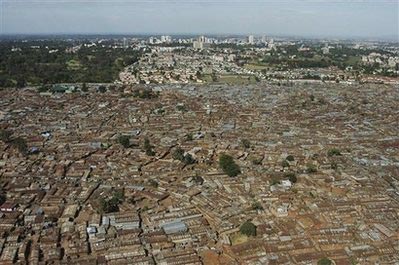Natural disasters are more frightening because of slums
The rampant development of many urban slums along with the greenhouse effect is increasing the level of danger of natural disasters.

Kibera slum in Nairobi, Kenya.Photo: AP.
UN scientists have conducted research on the trends of natural disasters and strategies to reduce their level of destruction. They published research results in Bahrain yesterday.
In the nearly 200-page report, the expert team reiterated the warning of previous studies, whereby indiscriminate urban development and a lack of vision in rural planning caused the extent of the destruction Nature painting has increased many times. The report also clarifies the link between climate change and the severity and frequency of disasters (such as droughts and storms).
According to reports, at least 900 million people around the world are living in shanty buildings in urban areas prone to earthquakes, tornadoes, flood attacks. The number of such people increases by 25 million per year on average.
A model shows many of the more than 19 million people living in the capital of the Philippines and the surrounding areas will be swept away if the tsunami attacks. India, China and many other places in Asia face "super disasters". Two of them were the super typhoon Nargis in Myanmar (which killed about 140,000 people) and the earthquake in China (causing nearly 90,000 deaths and 5 million homelessness).
'Asia faces huge risks from super disasters , ' UN Secretary-General Ban Ki-moon told a news conference yesterday in Bahrain. According to him, more than 300 natural disasters across the planet last year cost more than $ 180 billion. Disaster risk, poverty and climate change are becoming one of the world's greatest challenges.
Andrew Maskrey, the lead researcher, admits that it is unimaginable to stop the flow of rural-urban migrants from finding jobs. 'But we always have ways to ease poverty if leaders are really determined. Many cities around the world have implemented programs to improve living conditions in slums and makeshift houses. These programs are working very well, ' he added.
- Japan: The country suffers from many natural disasters and the way to protect people makes the whole world admired
- 2012: Many natural disasters, no disasters
- Talking numbers about the consequences of natural disasters
- More than 220,000 people died from natural disasters in 2008
- 5 most catastrophic natural disasters in human history
- The worst natural disasters in 2015
- The era of super disasters in Asia
- Looking back at the 10 worst natural disasters in American history
- 10 worst disasters in US history
- Australia is trying to overcome the consequences of natural disasters
- 2010 - the number of people killed by unusually high natural disasters
- The most severe places of natural disasters on Earth (Part 1)
 Is the magnetic North Pole shift dangerous to humanity?
Is the magnetic North Pole shift dangerous to humanity? Washington legalizes the recycling of human bodies into fertilizer
Washington legalizes the recycling of human bodies into fertilizer Lightning stone - the mysterious guest
Lightning stone - the mysterious guest Stunned by the mysterious sunset, strange appearance
Stunned by the mysterious sunset, strange appearance How are natural disasters classified?
How are natural disasters classified?  By 2030, there may be 1.5 natural disasters every day
By 2030, there may be 1.5 natural disasters every day  Learn the disasters that destroyed ancient Egypt
Learn the disasters that destroyed ancient Egypt  Indonesia studies using elephants to alert earthquakes
Indonesia studies using elephants to alert earthquakes  Startled 'security' to control the weather, causing natural disasters in China?
Startled 'security' to control the weather, causing natural disasters in China?  The risk of activating super volcanoes can kill millions
The risk of activating super volcanoes can kill millions 